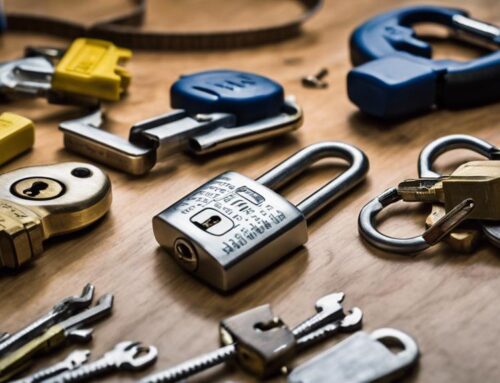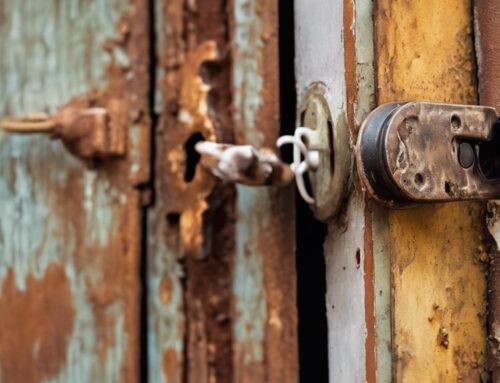Secure a door without a traditional lock by employing various innovative methods. Use a wooden wedge or doorstop to jam the door shut or slide a chair under the doorknob at an angle for added friction. Install a door security bar or reinforce the frame with metal plates. Consider smart locks with keypads or Bluetooth for keyless entry. Motion-activated door alarms and smart door sensors provide real-time alerts and deter intruders. Position security cameras or install doorbell cameras for continuous monitoring. These techniques enhance security effectively, providing you with peace of mind and robust protection. To explore all options in detail, continue onward.
Key Takeaways
- Use a wooden wedge or doorstop to jam the door shut and increase friction.
- Secure the door by sliding a chair under the doorknob at an angle.
- Utilize heavy furniture or stacked drawers to create a barricade in front of the door.
- Install motion-activated door alarms to receive immediate alerts and deter intruders.
- Position wireless security cameras for real-time monitoring and integration with smart home devices.
Improvised Door Locks
When you need to secure a door without a traditional lock, you can often use improvised methods like a wooden wedge or doorstop to jam it shut. To start, place the wedge or doorstop firmly under the door. This method provides a simple and effective temporary lock by increasing friction between the door and the floor, preventing it from opening.
Another method involves tying a rope tightly around the doorknob and a heavy object inside the room. Make sure the knot is secure and the rope taut. This technique restricts the movement of the door handle, enhancing security without a traditional lock.
You can also slide a chair under the doorknob at an angle. Position the chair so that the backrest is pressed against the door handle. This creates a physical barrier, making it difficult to turn the handle and open the door.
For additional security, insert a thick book or plank between the door and the frame. This creates a makeshift barrier, preventing the door from opening. These portable and practical solutions allow you to lock a door without traditional mechanisms, enhancing security in emergency situations.
Reinforcing the Door

Enhancing door security involves strategic upgrades such as installing a door security bar and reinforcing the door frame with metal plates to deter forced entry. Start by considering a solid core door or a metal door, both of which offer increased strength and resistance to break-ins. These types of doors are more robust than hollow-core doors and can withstand significant force.
Next, reinforce the door frame. Install metal strike plates around the lock area to strengthen the frame. These plates distribute the force exerted on the lock, making it harder for intruders to break through. You should also install a deadbolt lock, which provides an extra layer of security and is more resistant to tampering.
Don’t overlook the significance of hinge bolts. These bolts secure the door to the frame, preventing it from being lifted off its hinges. They’re especially vital if your door swings outward.
Door Barricades
Door barricades serve as effective physical barriers to prevent unauthorized entry and enhance overall security. These devices provide an additional layer of protection, especially valuable in emergency situations. Traditional door barricades can be as simple as heavy furniture or stacked drawers. Placing a chair or other substantial object in front of a door acts as a makeshift door barricade, utilizing available resources quickly.
For more robust door security, specialized door barricade devices and door security braces are available. These devices are designed to reinforce doors against forced entry. A door security brace is a bar that fits securely between the floor and the doorknob, making it difficult for intruders to push the door open. Similarly, door barricade devices can be installed at the base of the door, providing a low-profile yet highly effective barrier.
When choosing a door barricade, consider the material and design. Steel or heavy-duty plastic ensures durability and long-term reliability. Implementing these tools not only enhances security measures but also provides peace of mind. In emergency situations, having a reliable door barricade can be essential for your safety and security.
Smart Locks and Keyless Entry

Beyond physical barricades, smart locks and keyless entry systems offer advanced technological solutions for securing doors without traditional locks. These systems combine convenience with enhanced security, ensuring you’re never left fumbling for keys again.
Smart locks often use keypads or digital codes, allowing you to set and change codes as needed. This keyless entry method eliminates the need for traditional keys and offers a high level of security. Bluetooth-enabled locks take this a step further by allowing you to control access via your smartphone. Simply install the appropriate app, and you can lock or unseal your door from anywhere, enhancing both accessibility and control.
For those seeking even more advanced security, biometric locks are an ideal choice. These systems use fingerprint or facial recognition technology to grant access, ensuring only authorized individuals can enter. The precision of biometric data significantly decreases the risk of unauthorized entry.
Remote-controlled locks add another layer of convenience, letting you manage your door’s security from a distance. Using a mobile app or remote control, you can lock or unseal your door, providing flexibility for various scenarios, such as letting in a guest while you’re away.
Door Alarms and Sensors

To enhance your door’s security without a traditional lock, consider installing motion-activated door alarms that trigger alerts upon detecting movement. Smart door sensors offer real-time monitoring and notifications, ensuring you’re always aware of unauthorized entries. Additionally, doorbell cameras with motion detection provide visual verification of visitors, adding another layer of protection.
Motion-Activated Door Alarms
Motion-activated door alarms provide an effective and immediate alert system by detecting any movement near the entry point. These devices serve as an additional layer of security, ensuring that any unauthorized entry is promptly noticed. By incorporating a door alarm with motion detection into your smart security system, you achieve enhanced monitoring for both residential and commercial use.
Here’s how motion-activated door alarms can protect your property:
- Immediate Alerts: The alarm triggers as soon as motion is detected, offering instant notifications.
- Deterrent Effect: The presence of the alarm itself can deter potential intruders from attempting to enter.
- Integration with Smart Systems: Seamlessly connect with your existing smart security system for thorough oversight.
- Versatile Application: Suitable for residential use to safeguard your home, and commercial use to protect business premises.
Installing a door alarm with motion detection brings peace of mind by providing quick alerts to potential threats. This proactive measure not only protects against unauthorized entry but also adds a robust layer of security to your environment. Whether you’re securing a home or a business, motion-activated door alarms are a critical component in maintaining safety and vigilance.
Smart Door Sensors
Smart door sensors offer a sophisticated way to enhance your security system by detecting unauthorized entry and providing real-time alerts. By installing door/window sensors, you can immediately know when a door or window is opened. These sensors trigger an audible alert, notifying you of potential security breaches. Smart door sensors are often integrated into smart security systems, offering thorough monitoring and control via your smartphone.
Motion sensors placed near the door can detect movement, activating the alarm system to deter intruders. These sensors are highly effective as they provide an additional layer of security by monitoring for unexpected activity. When paired with door alarms, they create a robust security setup that alerts you to any suspicious behavior.
Incorporating doorbell cameras with built-in motion detection further enhances security. These devices capture footage of anyone approaching your door, serving as a visual deterrent and providing valuable evidence in case of an incident. Real-time notifications from your smart security system keep you informed, allowing for immediate action if needed.
Doorbell Camera Alerts
Doorbell cameras equipped with motion detection send instant alerts to your phone, providing real-time video footage and immediate notifications of any activity at your door. This technology enhances your home’s security by allowing you to monitor your entrance remotely.
Here’s what you can expect from a doorbell camera with advanced features:
- Motion Detection: Detects movement and sends doorbell camera alerts directly to your phone, ensuring you’re aware of any activity.
- Real-Time Video Footage: Offers live streaming, so you can see who’s at your door instantly.
- Two-Way Audio: Enables you to communicate with visitors, whether they’re guests or potential intruders, without having to open the door.
- Integration with Door Alarms: When used with motion sensors and door sensors, it enhances your smart security system by providing inclusive monitoring.
Security Cameras

Security cameras offer multiple benefits for door security, including real-time monitoring and visual confirmation through video doorbells. You can enhance security with discreet surveillance options like hidden or peephole cameras. For thorough coverage, consider wireless camera systems that guarantee continuous observation without the need for extensive wiring.
Video Doorbell Advantages
When you set up a video doorbell, you gain the ability to monitor your doorstep in real-time and interact with visitors remotely, greatly enhancing your home security. Video doorbells offer several key advantages that make them an essential component of modern home security systems.
- Live monitoring: With video doorbells, you can watch live footage of your doorstep from anywhere. This live monitoring ensures you’re always aware of who is at your door.
- Motion detection alerts: These devices are equipped with motion sensors that send alerts to your smartphone whenever movement is detected, allowing you to quickly evaluate potential threats.
- Two-way audio communication: This feature allows you to speak directly to visitors through your doorbell, whether you’re at home or away. It’s particularly useful for providing instructions to delivery personnel or discouraging intruders.
- Video recording capabilities: Video doorbells can record footage of all activities at your doorstep. This serves as valuable evidence in case of suspicious activities or break-ins.
Discreet Surveillance Options
While video doorbells offer valuable real-time interaction, installing discreet security cameras around your entry points provides continuous, unobtrusive monitoring to further enhance your home’s defenses. These surveillance options allow you to keep a watchful eye on your property without drawing attention to the fact that you are monitoring the area.
Choose security cameras with 24/7 recording capabilities to ensure every moment is captured, providing a thorough log of any activity near your door. Opt for models with motion detection features that alert you to any movement, offering an extra layer of security. Wireless security camera systems can be easily installed near entry points, offering extensive coverage without the need for extensive wiring.
Integrate these cameras with other security measures like portable door locks and adjustable door jammers for a multi-faceted defense strategy. DIY security bars and security bars can also be used to physically reinforce your door while the cameras provide visual oversight.
Wireless Camera Systems
Wireless camera systems frequently offer a versatile and convenient solution for monitoring your door, combining ease of installation with advanced features like motion detection and night vision. These systems not only help you secure a door without a traditional lock but also provide real-time surveillance, enabling you to monitor activity remotely via a smartphone or computer.
To effectively utilize wireless camera systems, follow these steps:
- Choose a location: Position the camera where it can capture the entire doorway. Confirm it has a clear, unobstructed view.
- Install the camera: Most wireless cameras are DIY-friendly. Simply mount them using screws or adhesive strips, and connect to a power source.
- Configure settings: Use the manufacturer’s app to connect your camera to your Wi-Fi network. Enable motion detection, night vision, and two-way audio features.
- Integrate with smart home devices: Link your camera to other security systems for thorough protection.
Wireless camera systems complement other security measures like a portable door lock or a door jammer, providing an additional layer of safety. Whether you choose to install a floor-mounted lock, use pliers to bend a metal plate for reinforcement, or block the door with a security device, integrating a wireless camera guarantees you’re always in control.
Security Barriers

Enhancing your home’s security can be effectively achieved by installing security barriers like security bars, grilles, and reinforced films. These solutions provide substantial protection for your doors and windows. For instance, using a door without the need for traditional locks can be secured with a strike plate lock. This device reinforces the door latch and door handles, making it more challenging for intruders to force entry.
Security bars or grilles can be installed over windows and glass doors to deter break-ins. These barriers act as physical deterrents, preventing unauthorized access. Another method is applying window security film to glass surfaces. This film holds the glass together even if it is shattered, adding an extra layer of protection.
To secure the door further, you can install a security gate or security screen door. These barriers provide an additional obstacle that intruders must overcome. Additionally, using a door jammer can effectively prevent forced entry by bracing the door from the inside. These measures enhance your home security, ensuring that the door is locked without relying solely on traditional locks. Implementing these barriers can make a significant difference in the safety of your home.
Access Control Systems

In addition to physical security barriers, implementing access control systems can greatly enhance the security of your home by regulating who can enter through the use of key cards, fobs, or biometric identifiers. Access control systems offer a range of options tailored to different security needs and preferences.
- Biometric Access Control: Utilize unique physical traits such as fingerprints or facial recognition for entry. These systems provide high security as they rely on biometrics, which are difficult to replicate.
- Keypad Access Control: Users enter a specific code to gain access. This method is straightforward and doesn’t necessitate carrying physical keys.
- Intercom Systems: Enable communication with visitors before granting entry. Many intercom systems now include door release functions, combining convenience with security.
- Proximity Card Access Control: Uses proximity cards or fobs that emit a signal to open the door when in close range. This method is both secure and convenient, eliminating the need for physical contact.
Each of these systems can be customized to fit your specific security needs. By integrating access control systems, you can guarantee that only authorized individuals gain entry to your home, providing peace of mind and enhanced protection.
Frequently Asked Questions
How Do You Secure a Door That Doesn’t Have a Lock?
To secure a door without a lock, use door barricades, security bars, or door stoppers. Reinforced hinges offer added strength. Smart technology like motion sensors, alarm systems, and magnetic door holders enhance security. Temporary solutions include privacy curtains.
How Do You Lock a Door Without a Lock From the Inside Diy?
To lock a door without a lock from the inside, you can use a makeshift barricade, door wedge, door jammer, sliding bolt, door stopper, latch guard, chain lock, flip lock, security bar, or door brace for added security.
What Can Be Used to Secure a Door?
Locking a door’s like fortifying a castle. Use door barricades for strength, wedge alarms for alerts, door chains for restraint, and door bars for reinforcement. Enhance security with smart locks, security cameras, motion sensors, door alarms, and keypad entry.
How Do You Secure a Door That Opens Outward Diy?
To secure an outward-opening door, install a door barricade, hinge reinforcement, or security bar. Use a deadbolt alternative or bolt latch. Add a door jammer, floor wedge, door brace, latch guard, or chain lock for enhanced protection.
Conclusion
Securing your door without a traditional lock isn’t just possible—it’s practically bulletproof. By combining improvised locks, door reinforcements, barricades, smart locks, alarms, cameras, barriers, and access control systems, you’re creating a fortress. Implement these measures meticulously, and your door will stand as an impenetrable barrier. Remember, security is about layers. Each method adds another line of defense, ensuring your home remains safe from any threat. With these tips, you’re not just securing a door; you’re fortifying your sanctuary.










